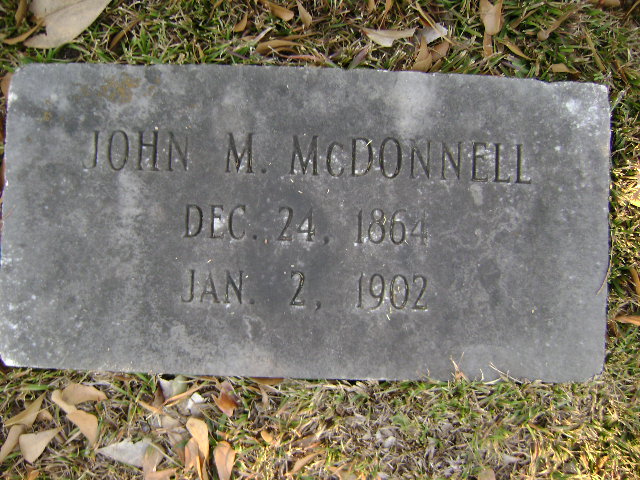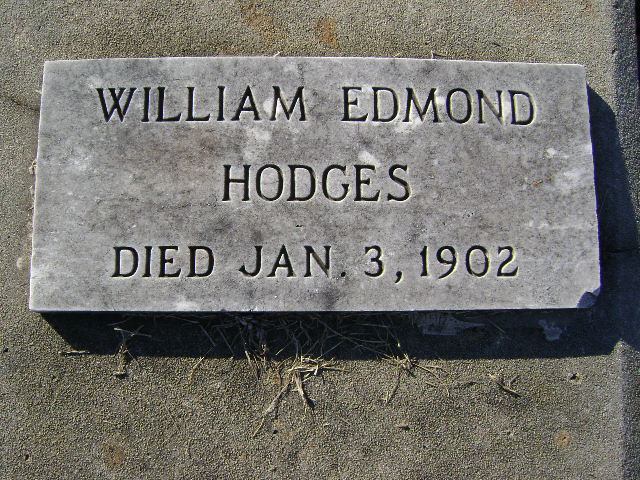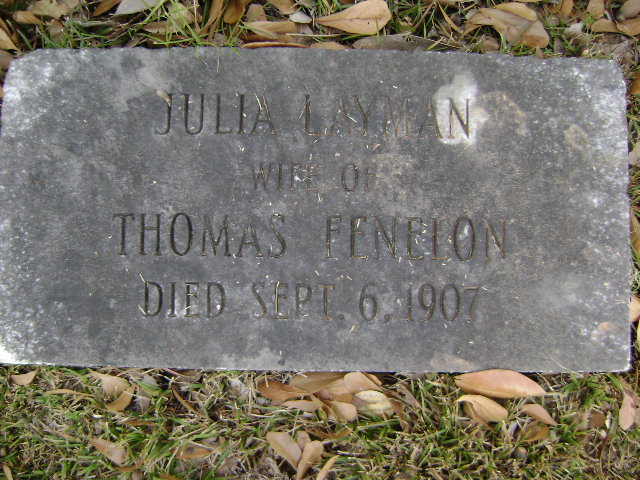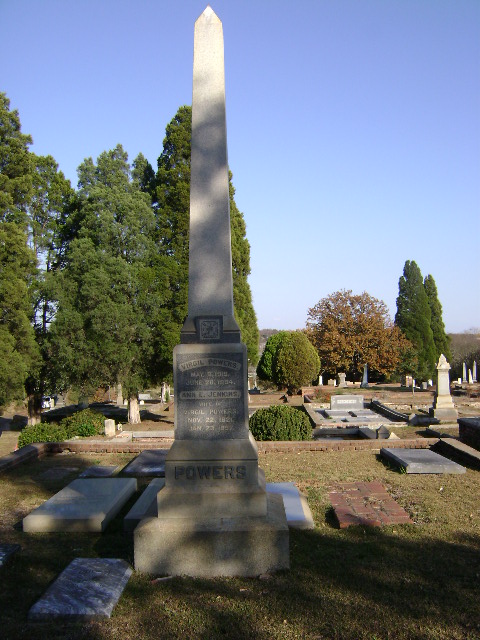Thursday, 14 July 1887 - pg. 3
AN OLD CITIZENMacon Telegraph (Georgia)
Lying at the Point of Death -- A Life of Vicissitudes.
MACON, Ga., July 13. -- [Special.] -- It is the opinion of competent physicians that it is now no longer a question of days, but of hours, when Jacob Russell shall have drawn his last breath. He has eaten nothing for several weeks except prepared milk in small quantities, and his son remains up with him every night awaiting the inevitable end.
Jacob Russell has a remarkable history. At the age of twenty-eight he left his native land, Bavaria, and came to this country...
His wife, who still lives, at the age of sixty-three, left Baden at the age of eight years, and grew to womanhood in America. In 1843 Jacob married her and set out to make a living. For thirty years they did a dry goods business on the corner of Pine street and Cotton avenue, where Charlie Russell now has a grocery store. The young Germans did well...
In [1860?] Russell and Peter Slenten started the first lagar beer brewery in Georgia. Russell put a lot of money into it, and the old buildings and cellars still remain, out on Vineville branch, in a dilapidated condition.
The firm secured a foreman from the west, who ruined their beer, and the concern bursted, leaving Russell with nothing but that property on Cotton avenue.
For a long time he was with L. W. Rasdal, and when the Aurora beer first appeared here Russell took the agency.
Finally he removed, in 1880, back to the Cotton avenue place and opened a grocery story [sic] where he has made money.
He has eight daughters and two sons, ten in all, seven of whom are married. He has twenty-four grandchildren, and two great grandchildren, all living and doing well.
The old man is passing away from the combined effects of rheumatism and old age, and his family think he will hardly survive the night. His long life has been one of honest and manly labor, and he has many friends in this city, where he has lived so long.
Friday, 15 July 1887 - pg. 5
Death of Jacob Russell, Esq.Atlanta Constitution (Georgia)
Mr. Jacob Russell died at his home on Cotton avenue at 11 o'clock last night after an illness of about a month.
He was nearly 74 years old, and came to Macon about 1834. He aided in building the old Monroe railroad, now the Atlanta division of the Central. He built the first brewery in Georgia, if not in the South, and was a member of the firm Russell & Peters, brewers, during the war and for some time afterward.
He made a good citizen, and was at one time one of the aldermen of the city, and held other places of honor and trust. He was a member of Germania Lodge of Odd Fellows, and was also an old member of the Macon Volunteers.
The funeral will take place this afternoon.
Saturday, 16 July 1887 - pg. 3
JACOB RUSSELL'S DEATH.Macon Telegraph (Georgia)
Some Additional Points About the Old Citizen.
MACON, Ga., July 15. -- [Special.] -- Last night Jacob Russell breathed his last, after a long and lingering illness. Mr. Russell was seventy-four years old. He came to Macon in 1837, and began life in good earnest. He was an officer on the old steamboat Goddard in the old steamboat days. When the State road was begun Mr. Russell took the first section on it, and he it was who built and named "Big Shanty," a few miles out of Atlanta. His wife was a Follindore. When she came to Macon she was brought on the river boat from Darien. The family has lived here ever since, and Mr. Russell could tell as many stories of the early history of the city as anybody.
On June 21st, last, he had a wine dinner, and invited some of his old friends to enjoy the semi-centennial celebration of his arrival in America. He was a member of Germania Lodge of Odd Fellows, and they will be present in a body at his funeral.
16 July 1887
Funeral of Mr. Russell.
The funeral of Mr. Jacob Russell took place yesterday afternoon from his late residence on Cotton avenue, and was largely attended. The services were conducted by Rev. Wm. McKay, and were very impressive. The remains were intered [sic] in Rose Hill cemetery, and the following gentlemen acted as pallbearers: Messrs. J. Madison Jones, Geo. B. Wells, H. P. Westcott, E. Sprinz, G. C. Conner and Valentine Kahn.
As stated yesterday, Mr. Russell was one of the oldest citizens of Macon, having come here in 1838. He built a section of the Monroe railroad, the second railroad built in Georgia. He followed the road to Atlanta, and then was engaged on the State road. He gave one of the stations the name of Big Shanty, which name it retains to this day. In 1860 he built with Mr. Julius Peter, the first brewery in the South the business of which was lost in the reverses that followed the close of the war. By dint of hard work and and [sic] close attention, built up a business on Cotton avenue which falls to his son, Mr. C. H. Russell...
Remarkably, the site of Georgia's first brewery was uncovered in 2017.
The Telegraph (Macon, Georgia)Georgia’s oldest brewery unveiled with widening of I-75 in Macon
BY LAURA CORLEY
OCTOBER 27, 2017 11:44 PM
There on a steep embankment between a blighted cemetery and Interstate 75, a deep, dark hole leads to a cave that is the site of what was likely Georgia’s first brewery.
The nearly 200-year-old beer cave is no secret to longtime residents in Macon’s Pleasant Hill neighborhood.
However, it was an unexpected discovery for Georgia Department of Transportation contract workers, which first saw it in September as they were cutting back trees to widen the interstate...
...Back in the late 1830s, the 50 feet deep cave was used to age ale and German lagers crafted by Russell & Peters’ Brewery.
Immigrants Jacob Russell, of Bavaria, and Julius Peters, of Germany, started brewing beer, distilling liquor and fermenting wine before the Civil War and continued during it, according to a 1938 Telegraph article...
...The cavern is beside Riverside Branch, which leads to the Ocmulgee River. [Chris Tsavatewa, professor at Middle Georgia State University] said kegs were shipped down to Darien.
'The significance of this cave not only resides in the industrial history of Macon, but the significance of the time period of which the brewery operated...Jacob Russell was a slave owner and the cave itself reveals thousands of pick marks on the inside that created the cave’s expansion...it was most likely done with slave labor.'
The cave, for the most part, is undisturbed...[Full article here.]
- Louisa Ella Russell, 1844-1915 (m. Julius Herman Otto in 1862)
- Julia Russell Hertel, b. abt 1845
- Mary A. Russell, b. abt 1847
- Lavinia Russell, 1849-1924 (m. Louis Vannucci)
- Aurelia Russell, d. 1929 (m. Louis Nelson)
- Emma C. Russell, b. abt 1853 (m. H. M. Taylor in 1875)
- Charles H. Russell, b. abt 1855
- Jacob Russell, b. abt 1856
- Robert Russell, b. abt 1857
- Kate Russell, b. abt 1860
- Annie Russell, b. ant 1866






























